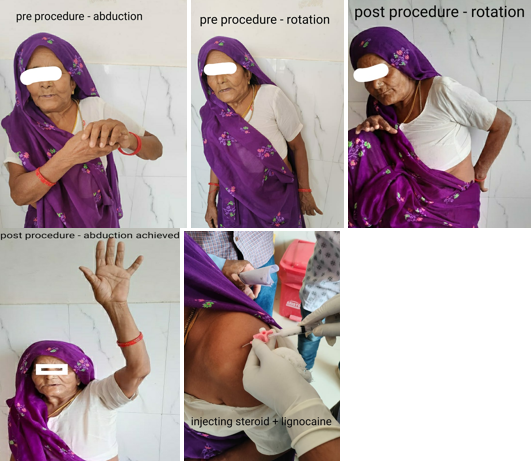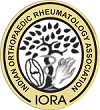- Visibility 10 Views
- Downloads 5 Downloads
- DOI 10.18231/j.ijor.2022.017
-
CrossMark
- Citation
Intra-articular steroid using lor technique in managing frozen shoulder
- Author Details:
-
Yogesh Kumar Agrawal
-
Saksham Sharma *
-
Sachin Pachori
-
Abhinav Sharma
Introduction
Idiopathic adhesive capsulitis also known as frozen shoulder a condition characterized by non specific inflammatory condition causing the joint capsule to become thick limiting the movement of shoulder joint presenting as painful limited shoulder functions.
The condition mostly is found in females between age groups of 40 to 60 years, more commonly in those who are diabetic or hypothyroid patients.
The treatment options remains controversial, while some advocate this to be a self resolving condition,[1], [2] while others have demonstrated incomplete recovery with persistent disability,[3] treatment options documented are physical rehabilitation,[4] non steroidal anti-inflammatory drugs, [5], [6] oral steroids, [7] intraarticular corticosteroid injection,[8], [9], [10], [11] distention arthrography, closed manipulation and arthroscopic capsular release.
The rationale for corticosteroid injection is to attempt to reduce synovial inflammation and prevention of secondary capsular fibrosis thereby improving the functional outcome.
Materials and Methods
28 patients all females without underlying diabetes presenting in orthopaedic out patient department of R.B.M. Hospital and Medical College, Bharatpur, Rajasthan with limited shopulder abduction to 90 degrees; were taken up for study after they failed to respond to conservative management of rehabilitation and NSAIDS for a period of 21 days. Any preexisting rotator cuff injury or glenohumeral arthritis was ruled out by clinical evaluation, history and radiographs, clinical diagnosis of frozen shoulder was confirmed.
Preparation
The procedure was done in out patient procedure room in complete aseptic conditions, the usual trolley consisted
5 ml sterile disposable syringe.
2 ml sterile disposable syringe.
80 mg / 2ml of methylprednisolone acetate.
2 ml of 2% lignocaine.
20 guage cannula.
Distil water ampule.
Technique: After painting and draping the postero inferior border of acromion was marked, tip of coracoid was palpated, 20 gauge cannula was inserted just beneath the acromial border marked amining towards the coracoid i.e. keeping the direction from postero-lateral to antero-medial; the advancement of cannula was stopped as soon as loss of resistance was felt, to further assure the presence in joint cavity the stylet was removed and 2ml syringe with air was connected and air was pushed to look for free flow within the cavity, once confirmed 5ml syringe was filled with 2ml of methylprednisolone acetate and 2 ml of 2% lignocaine, which was then pushed via the cannula into the joint cavity, next about 1 ml of distil water was pushed.
Cannula was removed and shoulder was manipulated in all directions, pendulum exercises were initiated for next 15 minutes and improvement in pain and range of motion was observed
Post procedure NSAIDS and physical rehabilitation of shoulder were explained.
Case illustration

Results
Of all 28 patients taken up for study, 22 had a significant improvement in range of motion about 30 minutes post procedure with all having improvement in pain.
The mean follow up was done for 6 weeks post procedure. 4 patients lost follow up, remaining 24 patients had improved outcome in terms of ability to do overhead abduction as well as rotation, there was limitation of some degrees of external rotation in 4 patients with minimal persistent pain.
Discussion
Multiple treatment options in a disabling condition poses challenges to the treating doctor in terms of optimum treatment choice.
Our hypothesis is of early chemical ablation of inflammatory cascade of synovial inflammation which forms the basic pathophysiology of adhesive capsulitis in turn preventing the resultant capsular fibrosis which is well documented in orthopaedic as well as rheumatological literature.[12], [13]
Vander Windt et al.[13] compared intra-articular steroid to physical therapy reports no significant difference in outcome in two groups at 52 weeks with early improvement of pain and range of motion in injection group at 3 and 7 weeks.
Gam et al.,[14] compared steroid only with steroid + lignocaine finding better results with combination therapy.
Bulgen et al., compared treatment with steroids v/s physical therapy or benign neglect and noted initial positive response to steroid group.
Conclusion
The technique described for intra-articular steroid is a minimally invasive, cost effective method with limited complications and an early response with simple technique. The documented complications of rotator cuff tears were not encountered as there was a limited sample size.
A pre-procedure confirmation of absence of glenohumeral arthritis and tendinopathy is a mandatory check.
Conflict of Interest
None.
Source of Funding
None.
References
- M D Miller, M A Wirth, C A Rockwood. Thawing the frozen shoulder: the “patient” patient. Orthopedics 1996. [Google Scholar] [Crossref]
- JW O’kane, S Jackins, JA Sidles, KL Smith, FA Matsen. Simple home program for frozen shoulder to improve patients’ assessment of shoulder function and health status. J Am Board Fam Pract 1999. [Google Scholar]
- B Shaffer, J E Tibone, R K Kerlan. Frozen shoulder. A long-term follow-up. J Bone Joint Surg Am 1992. [Google Scholar]
- A Binder, B L Hazleman, G Parr, S Roberts. A controlled study of oral prednisolone in frozen shoulder. Br J Rheumatol 1986. [Google Scholar]
- E C Huskisson, R Bryans. Diclofenac sodium in the treatment of painful stiff shoulder. Curr Med Res Opin 1983. [Google Scholar]
- H Owens-Burkhart. . Management of frozen shoulder. In: Donatelli R (ed) Physical therapy of the shoulder 1991. [Google Scholar]
- A I Binder, D Y Bulgen, B L Hazleman, S Roberts. Frozen shoulder: a long-term prospective study. Ann Rheum Dis 1984. [Google Scholar]
- D Y Bulgen, A I Binder, B L Hazleman, J Dutton, S Roberts. Frozen shoulder: prospective clinical study with an evaluation of three treatment regimens. Ann Rheum Dis 1984. [Google Scholar]
- J E Dacre, N Beeney, D L Scott. Injections and physiotherapy for the painful stiff shoulder. Ann Rheum Dis 1989. [Google Scholar]
- BA De Jong, R Dahmen, JA Hogeweg, RK Marti. Intra-articular triamcinolone acetonide injection in patients with capsulitis of the shoulder: a comparative study of two dose regimens. Clin Rehabil 1998. [Google Scholar]
- O Steinbrocker, T G Argyros. Frozen shoulder: treatment by local injections of depot corticosteroids. Arch Phys Med Rehabil 1974. [Google Scholar]
- T D Bunker, P P Anthony. The pathology of frozen shoulder. A Dupuytren-like disease. J Bone Joint Surg Br 1995. [Google Scholar]
- SA Rodeo, JA Hannafin, J Tom, RF Warren, TL Wickiewicz. Immunolocalization of cytokines and their receptors in adhesive capsulitis of the shoulder. J Orthop Res 1997. [Google Scholar]
- A N Gam, P Schydlowsky, I Rossel, L Remvig, EM Jensen. Treatment of “frozen shoulder” with distension and glucorticoid compared with glucorticoid alone, a randomized controlled trial. Scand J Rheumatol 1998. [Google Scholar] [Crossref]
